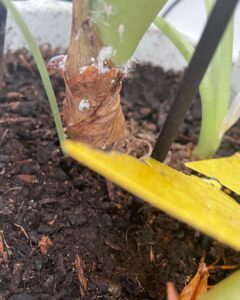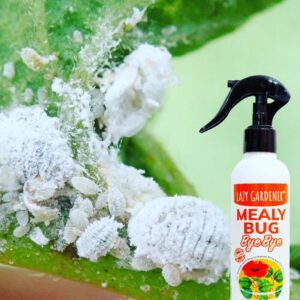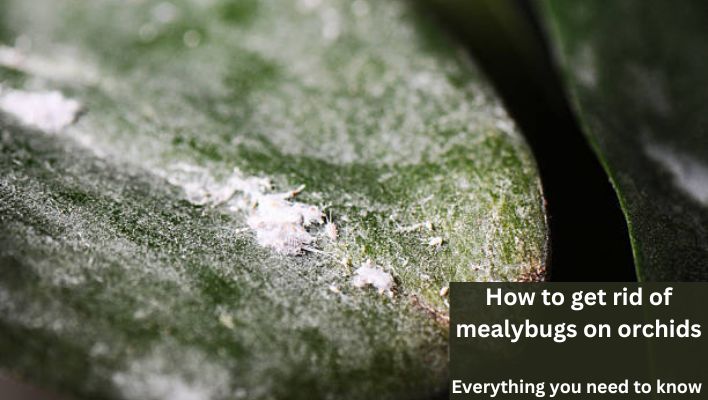In a previous post, we analyze how to kill mealybugs. But now we want to take that one step further and show you how to get rid of mealybugs on orchids because not all methods are suitable for your orchid.
If you have an orchid and notice white spots like powdery mildew on the leaves and stems, you may wonder what to do. If this is causing stunt growth, this may be a mealybugs infestation. Mealybugs are tiny insects that suck the juices from the leaves of plants, including orchids.
Mealybugs problem can quickly spread and become a nuisance. Not only do mealybugs damage the plants, but they also attract other pests that kill the plant.
There are several ways to get rid of mealybugs on orchids, but it’ll take some time for them to disappear completely. But sometimes, even these natural controls are not enough to keep mealybugs out of an orchid’s greenhouse or garden.
So what should you do if you see mealybugs on your orchids safely without hurting your plants? Below is everything you need to know about getting rid of mealybugs on orchids naturally and safely.
Signs of mealybugs on orchids
You should look for several signs if you think you’ve got mealybugs on your orchids. They’re often mistaken for spider mites, but they’re unrelated to spiders.
They don’t always look like a typical bug but are similar in size to aphids and often appear as white spots on the petals. If you suspect you have mealybugs, you should check your plants for signs of infestation.
Mealybugs are small insects that live in colonies. They produce a white, translucent secretion known as “honeydew” that they use as food. The insects usually make their home around the base of the plant itself, but they may also be found on the leaves and stems of green foliage.
They feed on plant sap and can cause damage to the roots of orchids and other plants. First, check the base of the plant for white, cotton-like material. This is a sign of infestation.
Other signs include:
- Brown spots on leaves and stems
- Spots that look like bubbles (these can be seen when they’re wet)
- Yellowing of the leaves and plants
- Leaves that are small and pale green rather than large and dark green
- Stunted growth
- Yellow spots on the edges of leaves (other diseases can also cause these)
- White spots of fungus on leaves (mold)

How to Check Plants for Mealybugs
If you’ve ever grown an orchid, you’ve probably encountered pests such as mealybugs. The tiny insects are so small they’re almost impossible to see, but they can cause serious problems if they’re not taken care of. Fortunately, there are several ways you can check your orchids for mealybugs and treat them before their damage becomes worse.
Here are the signs to look for:
- Examine the leaves of the plant. If you see any white spots, look closer to see if they have fuzzy bits around them. If so, you have mealybugs.
- Check for small holes in the leaf that look like those made by a pin.
- Check the stem and underside of a leaf with a magnifying glass to see any small white spots or yellowish-green mounds.
- Yellowing of the flower parts
- Look at the underside of an individual flower and see if there are any white spots or yellowish-green mounds on it.
- Use a hand lens or binoculars to inspect individual flowers up close for signs of mealybugs, such as small white spots on their undersides or yellowish-green mounds along their edges (especially near the margins).
What causes mealybugs on orchids
You might wonder what causes mealybugs to appear on your orchid, which is a good question. The short answer is that they’re usually caused by an issue with the plant itself.
Moisture is the most common cause of mealybugs on orchids. These peats thrive in crowded conditions where there’s low light and humidity, these conditions can attract mealybugs to your plants.
Orchid plants need a lot of water, but not too much. If you’re watering your orchids too much, they’re more likely to get mealybugs.
Another common cause for mealybugs is having too many plants in one area. You’ve probably heard the old saying, “too many cooks spoil the broth,” but it’s true when it comes to orchids.
If too many plants are crowded together, there won’t be enough air circulation around them, so the humidity won’t stay high enough for mealybugs to survive (or grow). Also, the presence of other pests can attract these pests.
Overwatering is another common cause of mealybugs on your orchids could be over-watering them. This can lead to fungal growth within the plant, making it look like it has been infested with these bugs. If this happens, try letting some water drain out so that it won’t drown out all the good nutrients already in the soil before planting them there.

Damage mealybugs cause to orchids.
Moth orchid mealybugs are a common pest of orchids. They’re tiny and cause a lot of damage to your plants. You can see their damage by looking at the leaves in the mid-to-late summer when they start to fall off.
Mealybugs are sap-sucking insects that suck sap from orchids and otter plants, and they do it in a way that makes them more likely to spread disease. They live on or in the corky layer of bark and leaves of orchids, where they feed on sap.
The most common damage mealybugs cause to orchids is weakening the plant’s defenses against other pests and diseases, but they can also feed on nutrients important to the plant’s health. They feed on the sap of orchid leaves and stems, which can weaken plants and cause them to lose their luster.
Damage mealybugs cause to orchids may be seen as a white film of wax over leaves, petals, and stems that resemble a honeycomb. The wax may also cause discoloration of parts of the plant.
These pests leave behind a sticky substance called honeydew. This substance attracts ants and other pests, carrying mealybug eggs away. This will enhance the spread of mealybugs in your garden. If you spot ants in your orchid, it may be because mealybugs have infested it.
If you find mealybugs on your orchid plant, you might want to treat it fast to prevent an infestation with insecticidal soap or horticultural oil so that they don’t reproduce in your home garden.
Best insecticide for orchids
If you are looking for a quick fix for your pesticide and insecticide problem on your orchids, then you need a proven, ready-to-use pesticide or insecticide. You can use many pesticides and insecticides, but are they safe for your plants?
This is very important to prevent damaging your plant while trying to treat it. Below are some effective and safe pesticides and insecticides for your orchids to keep them healthy.
Harris Neem Oil Spray for Plants
Harris Neem Oil Spray for Plants is an effective insecticide for orchids. It is effective enough to kill many flying bugs and roaches.
This product can be used indoors or outdoors on any kind of plant. It does not damage the foliage as other insecticides do, so you can use this product on all plants without worry. It is also safe for humans, pets, and children to use around your home or garden.
Harris Neem Oil Spray for Plants works best when applied directly to the leaves of your plants, but you can also spray it on the stems if needed. The spray will last up to three weeks after application; however, you should try reapplying every two weeks if there are still pests in your garden.
Earth’s Ally Insect Control for Plants
Earth’s Ally Insect Control for Plants is a unique insecticide that targets the insects that feed on your plants. It is made from natural ingredients and can be used for indoor and outdoor plants. It comes in a spray bottle, which makes it convenient to use.
This pesticide contains a special blend of essential oils and plant extracts designed to repel garden pests without harming your plants or being toxic to humans or animals. The formula also works well on mealybugs, aphids, wasps, ants, flies, mites, and other insects that may damage your plant.
The insecticide leaves no residue behind on your plants once it dries, so you can rest assured that it has worked its magic without contaminating your soil or leaving behind any harmful toxins that could harm other animals who might eat those same plants later on down the line when they don’t know better.
Safer Insect Killing Soap Concentrate
Safer Insect Killing Soap Concentrate is a great choice for orchids that insects attack. It’s safe and effective and kills bugs without harming your plants.
This makes it a great choice for orchids that are susceptible to insects like mosquitoes, gnats, and aphids.
This concentrated soap kills over 1,000 different types of insects. It has been formulated to be safe to use outdoors year-round while damaging even the toughest outdoor insects.
How to get rid of mealybugs on orchids
Spray the plant with neem oil
Neem oil is a plant-based pesticide that can be used to kill mealybugs. Neem oil contains chemicals that prevent the mealybugs from feeding. This will also kill any other insects that the mealybugs might attract.
Mix a few drops of neem oil with water and spray the plant with this mixture. You can apply this solution to any other infested parts of your orchid and leave it there for at least two days before washing it off completely.
Also, you can mist the leaves of your orchid with neem oil if you want to do this instead of spraying it directly onto your plants (Although the misting method is not effective as spraying).
You should repeat this process every two weeks to kill off all the mealybugs on your orchid plants. After this period, you should spray once a month until they are completely gone from your plants.
Treat with insecticidal soap.
Insecticidal soap uses the same mechanism as antifreeze: it disrupts the moisture in the mealybugs’ bodies and kills them. The soap also adds its scent to help kill the insects. Soap can be used directly on the mealybug infestation, or it can be used as a pre-treatment for all surfaces that have been exposed to mealybugs.
It’s usually made from a mixture of soaps, surfactants, and insecticides. The best way to use insecticidal soap is to apply it directly to the plant’s leaves or stems where the mealybugs are most active (for example, on the underside of leaves).
Soap will kill off any mealybugs that come into contact with it, so if you see any on your plants, just use a spray bottle with insecticide soap to kill them off. You can also use soapy water as a type of treatment for mealybugs as well as other pests like ants and flies.
Spray with isopropyl alcohol.
Isopropyl alcohol is a great way to kill mealybugs on plants. The best part? It’s cheap and easy to find. You can spray the plant with isopropyl alcohol or dip the affected area in isopropyl alcohol, killing any mealybugs on contact.
Just spray the orchid with isopropyl alcohol and wait for about five minutes. Then rinse the orchid with water and dry it with a paper towel.
This method works best if you have a large area of leaves that need treatment, so you don’t have to worry about using too much. Isopropyl alcohol effectively kills mealybugs, but be sure not to spray it on your plants or their pots. It can be toxic to them and will also damage the plant’s roots.
Use Diatomaceous earth
Diatomaceous earth is a natural powder you can buy at most home improvement stores and will help you get rid of mealybugs on your orchid. It’s made from tiny fossilized algae called diatoms, the same thing that makes up sand and soil.
You can sprinkle it directly on your orchid plants or even use it to lightly dust your pots before repotting your orchid plants. It’s safe for animals, humans, and plants.
Alternatively, Mix 1 tablespoon of DE with 1 quart of water, then sprinkle the solution on your orchids. The DE will dehydrate the mealybugs, killing them in the process.

Rubbing alcohol spray
You can also use rubbing alcohol spray to eliminate mealybugs on orchids. Just ensure that the area you spray is well-ventilated, and avoid getting the alcohol in your eyes.
First, you must remove any dead leaves or debris from the orchid that may be harboring mealybugs. Next, spray the mealybugs with rubbing alcohol and let them dry for a few minutes. Once they’re dry, you can brush them off with a soft-bristle toothbrush.
Use borax
Borax is pretty great at killing the mealybugs on your orchids. It’s also great at killing other outdoor pests, like whiteflies, aphids, and scale insects.
Borax is an organic compound that kills insects by dehydrating them and preventing them from creating a hard shell around themselves. It works well because it kills the mealybug eggs and the adults.
Mix 1/2 cup of borax to 2 cups of water in a spray bottle and shake well. Spray it onto your orchid and let it soak in for 15 minutes. You can repeat this step if you need to, but you don’t want to leave it soaking too long, or it could damage your flower.
Once you’ve soaked your orchid in the borax solution, rinse it off with lukewarm water and let it dry completely.
Use Hydrogen peroxide
Hydrogen peroxide is an effective way to kill these little bugs without harming your orchid. It will also kill any other insects that may have been feeding on your orchid. Hydrogen peroxide is safe for most plants if it’s diluted with water (or other liquids) before being applied.
You can spray your plants with a solution of hydrogen peroxide by mixing 1 part of hydrogen peroxide with 4 parts of water. You’ll have to ensure you do this only in a well-ventilated area so that any fumes you create don’t get into your lungs.
After spraying, leave the plant alone for about 12 hours before watering again; this will allow any leftover hydrogen peroxide to work its way into the soil, where it can kill more bugs.
Spray the plant with a strong jet of water.
To get rid of mealybugs on orchids, you can use a strong jet of water to blast them off. You can do this by using a jet sprayer if you are treating plants outdoors or a spray bottle while working on indoor plants.
Spray the plant with a strong jet of water. The best way to do this is to fill up a spray bottle with water and then add some liquid dish soap, which will help break apart the wax-like substance they secrete onto your plant’s leaves.
Make sure to shake the bottle before using it, so the soap beads have time to spread throughout the liquid. Then spray the plant with this solution until all visible mealybugs are removed.
Introduce a predator.
Another good way to get rid of mealybugs is with predators, species that eat the mealybugs, causing them to die by starvation. Predators should be introduced into your orchid immediately after you notice the problem. If you wait too long, the predators may not be able to find enough food in your orchid to survive and will eventually die off too.
Here are some good predators:
- Ladybugs
- Lacewings
- hoverfly
How to prevent orchids from mealybugs
Orchids are some of the most coveted plants in the world, with their intricate and beautiful blooms. Unfortunately, orchids also come with a few downsides. One of these downsides is the risk of mealybugs infestations.
Mealybugs are tiny insects that feed on plant sap. They can cause significant damage to orchid foliage and flowers, as well as damage to the plant’s roots. This can lead to a decline in your orchid plant’s overall health and vigor. The best way to prevent this is by getting rid of any mealybugs that may have infested your orchid plants before they spread further into your home or office space.
- Don’t put them in the same pot with other plants. Orchids need to be kept in pots that are strictly their own; they don’t do well with other types of soil and can’t handle mixing up with other resources.
- Remove any weeds or debris around the base of your orchid, which may be harboring mealybugs.
- Don’t water your plant when it’s in bloom (or just after blooming) since this can spread mealybugs throughout its root system.
- Keep them away from any insecticide treatments or pesticides. If you’re using insecticides or pesticides, treat the orchid pot and surrounding area with a diluted solution of 1 part bleach per 10 parts water before applying it to your orchids’ leaves or stems (this will kill any mealybugs that might be lurking inside). You can also use a neem-based spray to prevent mealybugs from infesting your orchids (and keep them from getting on you).
- Clean the pot regularly, especially if it’s been outdoors for any time during this time of year when mealybugs are most likely to appear. This is also important for indoor orchids, which can get trapped inside their pots by old leaves and debris from other plants growing nearby.
- If you have spots of mealybug infestation on leaves or stems, use an insecticidal soap spray on them every day for two weeks until they go away entirely (you can also try spraying them with rubbing alcohol). If they don’t respond to treatment within two weeks, consult your local garden center or a professional horticulturist for further recommendations about treating these pests.



